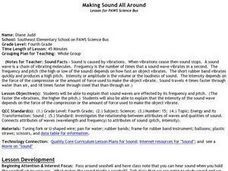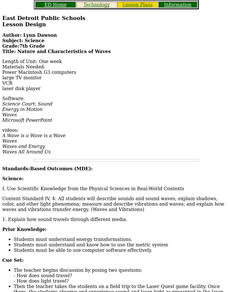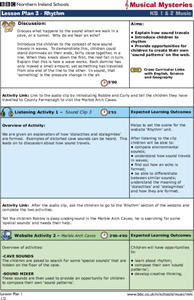Curated OER
TE Activity: Pitch and Frequency
Students experiment with a vibrating ruler and a kazoo to study the different pitches and frequencies they produce. They create both high and low pitch sound waves. They examine how engineers use sound energy when designing electronic...
Curated OER
Traveling Sound
Young scholars explore how sound waves move through liquids, solids and gases in a series of simple sound energy experiments. They describe how sound needs molecules to move and that changing the medium that it travels through changes...
Curated OER
Sound Waves
Sixth graders discover how sound is made from vibration and moves in all directions from the source in waves. They see that sound waves can be "seen" if they are translated into light. An excellent experiment is imbedded in this lesson.
Curated OER
Making Sound All Around
Fourth graders examine how sound waves are effected by frequency and pitch. They conduct experiments using tuning forks, rubber bands, balloons, and water, and answer questions about the experiments.
Curated OER
Sounds Like Science - Drums
Students see that understanding how sound is produced makes it possible for us to manipulate it so we can decrease the number of unpleasant sounds we encounter. They make a drum to explore the concepts of force, pitch and volume.
Curated OER
Lesson 3-Explore/Explain Do You Hear What I Hear?
Students explore how loudness is measured. They identify the decibel scale and explain the amplitude of the sound wave.
Curated OER
Sound
Students explore sound wave motion and conduct simple experiments to demonstrate how sound travels.
Curated OER
Nature and Characteristics of Waves
Seventh graders research different types of waves, identify the parts of a wave and create a Power Point presentation demonstrating what they have learned.
Curated OER
What Really Matters When it Comes to Sound?
Students conduct experiments to learn about sound wave vibrations in objects and pitch. Students test how varying the volume of water in a vessel changes frequency and pitch.
Curated OER
Chandra Spies the Longest Sound Wave in the Universe!
In this black hole worksheet, students use an x-ray image and a sound waves image to determine the size and the wavelength of the sound wave. This worksheet has 3 problems to solve.
Curated OER
Ears and Hearing
Students explore vibrations and sound waves. In this lesson about hearing, students use experiments to determine how sound waves travel. Students use a saucepan, rice, and a plastic cover for one experiment and a tube, plastic wrap, a...
Curated OER
Architectural Acoustics
In this acoustics activity, students use a chart of the speed of sound through different materials to determine which materials should be used to build certain building types. Students complete 2 short answer questions.
Curated OER
Hearing or Sound?
In this hearing worksheet, students complete a graphic organizer by filling in the steps between matter vibrating and hearing the sound.
Curated OER
How Do Waves Transfer Energy?
In this energy transfer worksheet, students will write down the 4 steps in the sequence that shows how waves transfer energy.
Curated OER
Sound
Second graders investigate the production of sound through experimentation. Working in pairs, 2nd graders receive supplies to create a sound machine. Once they create their machine and record the differences in the sounds produced.
Curated OER
Good Vibrations
Students demonstrate sound waves and make changes in the waves
resulting in changes in pitch. Students associate changes in pitch in various "musical instruments"with size and shape and the sound waves they produce.
Curated OER
Manipulate Sound Waves
First graders use the scientific process to investigate sound in the classroom and at home. They participate in several hands-on activities exploring sound. They then are introduced to sound vocabulary such as muffled, sharp, and tinkling.
Curated OER
Sounds Good To Me - Instrument Creation
Third graders differentiate between pitch and volume and explain how sound travels through different materials. They analyze sound waves for their basic characteristics. Students design an instrument based on the principles of sound...
Curated OER
Ride the Wave!
Young scholars examine how sonar works. They discuss the concept of sound waves, observe a demonstration of how sonar works using water, pie plates, and eyedroppers, and describe how sonar works in their own words.
Curated OER
Musical Mysteries
Students examine the changes that occur to sound as the pressure changes. Echoes and sound changes in caves and tunnels are explored in this lesson.
Curated OER
Sounds Like Science - Bottle Organ
Learners see that by manipulating sound we can arrange a series of notes referred to as a musical scale. They explain the relationship between pitches and notes. They compare the sounds of different-sized bottles.
Curated OER
Sounds Like Science - Guitars
Learners discover that all movement produces sound waves but not all sounds can be heard with the human ear. They experiment with a variety of substances to see which are audible and which are inaudible.
Curated OER
Sounds Like Science - Jamboree
Students create a delightful-sounding ensemble. They explore the subjective distinctions between noise and music. They use jars, buckets, boxes, strings, rackets, frames, string, rubber bands and bottles to make their own jamboree.
Curated OER
Sounds Like Science - Kazoo
Young scholars discover that energy is needed to produce sound. They see that identifying where the energy comes from enables us to control the type of sound produced. They play the kazoo and manipulate the sound in a variety of ways.

























